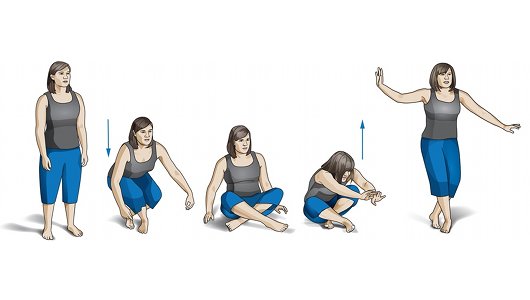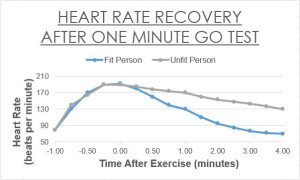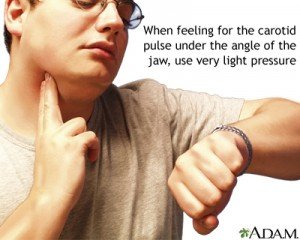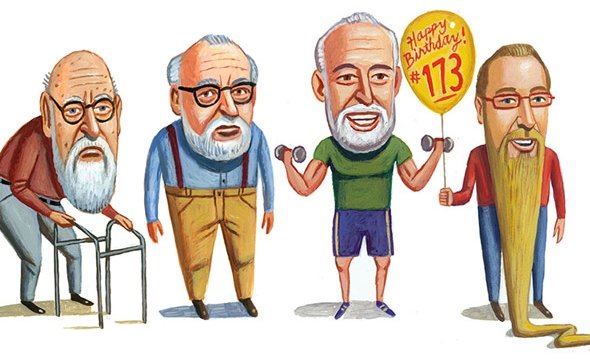Predict Your Lifespan By These 12 Tests
You can predict your lifespan to some degree right now by taking 12 tests that you can do yourself by yourself. If you test poorly, make some adjustments. The goal: Live a long and strong life!
UPDATE: October 4, 2021
Ever wonder if you’re on the right track to live not only a long life, but one full of vitality and strength? Well, you can test yourself right now with 12 different ways to predict your lifespan. And if things don’t look so rosy, I’ve included some ways you can make improvements.
(You can add these five blood tests to the mix, as recommended by Dr. Peter Attia.)
Read on and get going.
#1 Get stronger to live longer
As this 2018 study attests, strength training is critical to preserving the ability to maintain an active,  independent lifestyle with age. Sadly, between the age of 30 and 70, the average person will have lost about a quarter of their muscle strength, and for that person, half his/her strength will be gone by the age of 90.
independent lifestyle with age. Sadly, between the age of 30 and 70, the average person will have lost about a quarter of their muscle strength, and for that person, half his/her strength will be gone by the age of 90.
Low muscle strength was independently associated with elevated risk of all-cause mortality, regardless of muscle mass, metabolic syndrome, sedentary time, or LTPA [leisure-time physical activity ]among US older adults, indicating the importance of muscle strength in predicting aging-related health outcomes in older adults.
Without some sort of strength training and proper nutrition to feed them, muscles will become progressively weaker and less functional as you age.
The good news is that strength and muscle can be improved literally at any age. A beginning strength-training program can take as little as 20 minutes per session to accomplish. The key is to use proper form, do compound (multi-muscle) lifts, get proper rest between sessions (at least one day of per muscle group), proper nutrition and be consistent.
What to do?
#2 A simple strength test may predict heart attack, stroke
I’ve written quite a bit about how strength is positively correlated with longevity and how important it  is that we maintain our strength as we age. Turns out that there’s a simple strength test that may predict heart attack and strokes – grip strength!
is that we maintain our strength as we age. Turns out that there’s a simple strength test that may predict heart attack and strokes – grip strength!
Data analysis of a Prospective Urban Rural Epidemiology study of 139,691 adults aged 35 to 70 showed that every 5 kg (11 pounds) of declining grip strength was associated with a 16% increase in death from any cause, a 17% greater risk of cardiovascular death, and a 17% higher risk of non-cardiovascular mortality.
The study authors report that:
“This study suggests that measurement of grip strength is a simple, inexpensive risk-stratifying method for all-cause death, cardiovascular death, and cardiovascular disease.”
A hand dynamometer is typically used to perform the handgrip test, but you can also use a body weight scale (although it’s less accurate) for which there are two methods:
- Method 1– Stand on the scale and measure your body weight. Next, grab someplace you can hang from (a bar or hangboard) and, without bending your elbows and not using any part of your body other than your hands, tense your hands and pull up as much of your weight as possible for 5 seconds. Record what the scale says for the 5 seconds you’re tensing your hands. How much you weigh minus how much you weigh while tensing your hands equals your grip strength in pounds or kilograms.
- Method 2 – Grab a scale with both hands and extend your arms out in front of you so that the scale is about at chest level. Squeeze with all your might and record the highest mark the scale indicates.
The following tables show the average adult male and female grip strength and by various age groups as presented by Complete Strength Training:
Average Adult Male and Female Grip Strength per Hand
in Kilograms (Kg) (1 kg = 2.2 lbs)
| Classification | Male, Left | Male, Right | Female, Left | Female, Right |
| Excellent | > 68 | > 70 | > 37 | > 41 |
| Good | 56 – 67 | 62 – 69 | 34 – 36 | 38 – 40 |
| Average | 43 – 55 | 48 – 61 | 22 – 33 | 25 – 37 |
| Below Average | 39 – 42 | 41 – 47 | 18 – 21 | 22 – 24 |
| Poor | < 39 | < 41 | < 18 | < 22 |
30 – 39 Year Olds, Both Hands
| Rating | Male | Female |
| Excellent | ≥ 115 | ≥ 71 |
| Very Good | 104 – 114 | 63 – 70 |
| Good | 95 – 103 | 58 – 62 |
| Fair | 84 – 94 | 51 – 57 |
| Needs Improvement | ≤ 83 | ≤ 50 |
40 – 49 Year Olds, Both Hands
| Rating | Male | Female |
| Excellent | ≥ 108 | ≥ 69 |
| Very Good | 97 – 107 | 61 – 68 |
| Good | 88 – 96 | 54 – 60 |
| Fair | 80 – 87 | 49 – 53 |
| Needs Improvement | ≤ 79 | ≤ 48 |
50 – 59 Year Olds, Both Hands
| Rating | Male | Female |
| Excellent | ≥ 101 | ≥ 61 |
| Very Good | 92 – 100 | 54 – 60 |
| Good | 84 – 91 | 49 – 53 |
| Fair | 76 – 83 | 45 – 48 |
| Needs Improvement | ≤ 75 | ≤ 44 |
60 – 69 Year Olds, Both Hands
| Rating | Male | Female |
| Excellent | ≥ 100 | ≥ 54 |
| Very Good | 91 – 99 | 48 – 53 |
| Good | 84 – 90 | 45 – 47 |
| Fair | 73 – 83 | 41 – 44 |
| Needs Improvement | ≤ 72 | ≤ 40 |
What to do?
#3 Poor performance on “The Sitting-Rising Test” can lead to premature death
The “sitting-rising test” measures your fitness at the most basic level. It not only tests muscular strength,  but also flexibility, balance and motor coordination. All of these attributes are essential for day-to-day living, and for maintaining your independence as you age; therefore this test can predict your lifespan to some degree.
but also flexibility, balance and motor coordination. All of these attributes are essential for day-to-day living, and for maintaining your independence as you age; therefore this test can predict your lifespan to some degree.
Nearly any child can do the sitting-rising test and it’s not because they’re strong. A child squats, twists, turns, kneels, jumps and runs all day and that all makes them mobile. By the time we’re adults, we don’t move like a child, nor do most of us replace those childhood activities with consistent stretch and do mobility exercises; thus, with age comes tightness and restricted mobility.
A Brazilian study determined that:
- How well you can sit and rise from the floor, without using assistance from your hands, knees or other body parts, may predict your risk of dying prematurely in the next six years.
- Those who scored the lowest, requiring the most assistance to sit and rise from the floor, were 6.5 times more likely to die during the study period than those who scored the highest.
In one study of subjects between the ages of 51 and 80, those with scores in the lowest range (0 to 3) were 5 to 6 times more likely to die within the study period (about 6 years) than those in the group with the highest scores (8 to 10).
(Go here to see videos and read more about this.)
What to do?
#4 Walking speed is related to lifespan
Stephanie Studenski, M.D., M.P.H., of the University of Pittsburgh, and colleagues conducted a study to  assess the association of gait speed with survival in older adults and to determine the degree to which gait speed explains variability in survival after accounting for age and sex.
assess the association of gait speed with survival in older adults and to determine the degree to which gait speed explains variability in survival after accounting for age and sex.
The researchers found that gait speed was associated with differences in the probability of survival at all ages in both sexes, but was especially informative after age 75 years. At this age, predicted 10-year survival across the range of gait speeds ranged from 19 percent to 87 percent in men and from 35% to 91% in women.
Predicted years of remaining life for each sex and age increased as gait speed increased, with a gait speed of about 0.8 meters [2.6 feet]/second at the median [midpoint] life expectancy at most ages for both sexes. Gait speeds of 1.0 meter [3.3 feet]/second or higher consistently demonstrated survival that was longer than expected by age and sex alone.
Gait speed might be used to identify older adults with increased risk of early mortality, perhaps those with gait speeds slower than 0.6 meter (2 feet)/second.
Why would gait speed predict your lifespan? Walking requires energy, movement control, and support and places demands on multiple organ systems, including the heart, lungs, circulatory, nervous, and musculoskeletal systems. Slowing gait may reflect both damaged systems and a high-energy cost of walking.
What to do?
#5 Heart rate recovery predicts both fitness and mortality risk
How quickly your heart rate recovers after a heart-thumping workout not only indicates fitness but your  risk of dying prematurely, says this 2018 study, which confirmed the hypothesis that heart rate recovery not only predicts total mortality (from all causes), but is an even stronger predictor of cardiovascular death and, surprisingly, also predicts non‐cardiovascular death.
risk of dying prematurely, says this 2018 study, which confirmed the hypothesis that heart rate recovery not only predicts total mortality (from all causes), but is an even stronger predictor of cardiovascular death and, surprisingly, also predicts non‐cardiovascular death.
You can do the following heart rate recovery test at home:
- Perform an activity that will make your heart race for two minutes, such as jump rope, jumping jacks or run.
- After two minutes, stop the activity and immediately count your pulse for 20 seconds, multiply it by 3 (to get the one minute pulse rate) and record the result.
- Check your pulse again in one minute and compare the two numbers.
The difference you want between the two numbers is 12 or greater, which indicates that your heart beat dropped by 12 or more beats after one minute of rest.
If your score was not 12 or greater, you need to improve your cardiovascular health and/or you have a greater than average chance of dying of heart-related problems over the next five years.
What to do?
#6 A high pulse rate will put you in the crypt faster
The higher the resting heart rate, the greater the risk for death. This dolorous conclusion comes  from a Danish study published in Heart where researchers tracked 2,798 participants’ heart rate and oxygen consumption data from 1986 thru 2011.
from a Danish study published in Heart where researchers tracked 2,798 participants’ heart rate and oxygen consumption data from 1986 thru 2011.
Here are some data points:
- Compared with men with rates of 50 beats a minute or less, those at 71 to 80 beats have a 51% greater risk of death.
- At 81 to 90 beats, the rate of death is doubled, and over 90, tripled.
- People with resting pulses of 80 beats per minute die four to five years earlier than those with pulses of 65 beats per minute.
“If you have two healthy people,” said the lead author of the Danish study, Dr. Magnus Thorsten Jensen, “exactly the same in physical fitness, age, blood pressure and so on, the person with the highest resting heart rate is more likely to have a shorter life span.” (Source)
What that means is that resting heart rate is an INDEPENDENT predictor of mortality. And what that means is that all by its lonesome, your resting pulse rate can indicate mortality risk and is a great way to predict your lifespan.
What to do?
Once you have the number, you can go to the Life Expectancy Estimator by Hearth Rate site, type in your resting pulse and, magically, predict your lifespan.
#7 A large waist circumference increases mortality risk
Having a large waist size doubled the risk of dying from any cause during the nine-year period of  the study as compared to those with smaller waists, and this was true whether the person was of normal weight, overweight or obese. That’s the conclusion of the American Cancer Society study of more than 100,000 people over nine years.
the study as compared to those with smaller waists, and this was true whether the person was of normal weight, overweight or obese. That’s the conclusion of the American Cancer Society study of more than 100,000 people over nine years.
The key metrics are:
- For men, a waist size of 47 inches or larger.
- For women, a waist size of 42 inches or larger.
- For anyone, your waist should not exceed half the length of your height.
Having a large waist is correlated with large amounts of visceral fat around the abdominal organs, which can cause inflammation, high cholesterol, insulin resistance and other problems linked with poor health, which is why it be a useful measure to predict your lifespan.
Importantly, your waist measurement should be no more than half the length of your height, as I describe here.
What to do?
Need to lose belly fat? Rub your eyes, sit down (better yet, walk on a treadmill) and read some of these articles I’ve written.
#8 Reaction time can predict your lifespan
How fast you can react to certain stimuli can predict your lifespan. 
One study measured the reaction time of over 5,000 young and middle-aged adults. Then, controlling for various health risk factors, researchers compared the reaction time results to longevity.
As you might expect, there was a strong correlation between reaction time speed and longevity: those with faster reaction times predictably lived longer.
You may test yourself here.
What to do?
#9 Positive emotions extend life expectancy by ten years
According to researchers at the University of Kentucky, a positive attitude to life can add more than a  decade to your life expectancy. The more positive your attitude to life is – the more optimistic, upbeat, content and happy you are – the longer you are likely to live.
decade to your life expectancy. The more positive your attitude to life is – the more optimistic, upbeat, content and happy you are – the longer you are likely to live.
It makes sense that there’s a relationship between emotions and life expectancy. Negative emotions, such as sadness, fear, disgust and worry raise the heartbeat and blood pressure and increase the likelihood of cardiovascular disease – all which can cause both emotional and physical stress. Conversely, positive feelings such as optimism inhibit the negative impact of stress on the cardiovascular system. If your future outlook is positive, negative events will cause less stress.
The researchers base this bold assertion based on research done with 180 nuns. It turns out that nuns were a good cohort to study because they all live a similar lifestyle with predictable and consistent characteristics that impact life expectancy, such as marital status, social activities, smoking and alcohol, access to medical facilities and physical activity. This consistency made it easier to focus on the presence of positive emotions.
Autobiographies written by each nun between the ages of 18 and 32 ascertained these “positive emotions”. Nuns that had written about the most different types of positive emotions had a four times lower risk of mortality than the nuns who expressed the fewest positive emotions. The difference in life expectancy between these two groups was 10.7 years.
What to do?
#10 Your word use reveal the age you are likely to reach
The nuns wrote autobiographies and so did a group of psychologists in the sixties, two of which discovered  that they could predict from their colleagues’ word use how long they would live. The more often the psychologists used words with a positive emotional overtone, the older they lived.
that they could predict from their colleagues’ word use how long they would live. The more often the psychologists used words with a positive emotional overtone, the older they lived.
In 2012, Sarah Pressman, of the University of Kansas, and Sheldon Cohen, of Carnegie Mellon University, used a refined classification for words with emotional overtones, distinguishing between four sorts of words rather than just two. They first looked for words with a ‘high activated positive affect’; words like happy, active, energetic, lively and enthusiastic. Then they looked for words with an ‘unactivated positive affect’, such as calm, relaxed and content.
The researchers also distinguished between high activated and inactivated for words with negative emotional overtones. They distinguished between words with a ‘high activated negative affect’, such as worried, jittery, distressed and upset, and words with an ‘inactivated negative affect’, such as sad, lonely, downhearted and hopeless.
When the researchers looked at which type of words with a high-activated positive affect had the strongest correlation with a longer lifespan, words related to humor were most noticeable, and those who used many of such humorous words in their autobiography lived six years longer than psychologists who had used few humorous words.
The researchers reasoned that this might occur due to “… physiological changes that occur in conjunction with arousing positive emotional experiences (improved vagal tone, increased endogenous opioids) that contribute to better health. These changes may improve health through their influences on immune and cardiovascular function and may also aid in buffering physiological stress responses.”
What to do?
#11 No fear of aging extends life expectancy
When it comes to life expectancy, like in war, the “only thing to fear is fear itself”(Winston Churchill). This  is so because life expectancy isn’t based on some immutable equation dominated by genes and lifestyle variables, but (also) by how you feel about aging, according to an article by epidemiologists written over ten years ago in the Journal of Personality and Social Psychology. (Summary here.)
is so because life expectancy isn’t based on some immutable equation dominated by genes and lifestyle variables, but (also) by how you feel about aging, according to an article by epidemiologists written over ten years ago in the Journal of Personality and Social Psychology. (Summary here.)
If you approach your golden years calmly, you’ll live seven years longer than if you dread impending old age, say the scientists.
What to do?
Over 20 years ago I reread the Dune Trilogy, by Frank Herbert and committed this to memory:
I must not fear. Fear is the mind-killer. Fear is the little-death that brings total obliteration. I will face my fear. I will permit it to pass over me and through me. And when it has gone past I will turn the inner eye to see its path. Where the fear has gone there will be nothing. Only I will remain.
When I notice that fear is guiding my thoughts, emotions and actions, I recite Herbert’s quote. It calms things down. Suggest you try it too, or at least notice when your thoughts, emotions and actions are fueled by fear.
#12 Tooth loss predicts cardiovascular disease
Missing five teeth correlates to a 140% increased risk for coronary heart disease and heart attack. 
Various studies have shown that that a chronic inflammatory disease affecting the teeth and gums increase the risk of atherosclerotic vascular disease. To test this further, J.M. Liljestrand, from the University of Helsinki (Finland), and colleagues assessed the correlation between the number of missing teeth and incident cardiovascular diseases (CVDs), diabetes, and all-cause death. (Summarized here.)
The Helsinki team collected data on 8,446 participants, ages 25 to 75 years, with 13 years of follow-up and found that more than five missing teeth increased the risk for coronary heart disease events and myocardial infarctions by 140%. More than nine missing teeth indicated an increased risk for cardiovascular diseases (51%), diabetes (31%) and death (37%).
They said:
“Even a few missing teeth may indicate an increased risk of [cardiovascular disease], diabetes, or all-cause mortality… When individual risk factors for chronic diseases are assessed, the number of missing teeth could be a useful additional indicator for general medical practitioners.”
What to do?
Your Takeaway
Consciously living a long and strong life necessitates testing yourself from time to time to see if you’re on the right track. You now have 12 relatively easy to do, self-administered tests to check out how you’re doing.
The key things to remember:
- Keep strong and mobile
- Maintain (or improve) cardio conditioning
- Keep your teeth and gums in good condition
- Develop a joyous, fear-free attitude full of positivism
I often exhort readers to make new habits with the help of friends. A friend that is committed to take the journey with you can encourage, make you accountable and simply make everything more fun.
Next up:
Dr. Peter Attia — “The Top Five Biological Tests Everyone Should Take”
Last Updated on August 12, 2022 by Joe Garma




